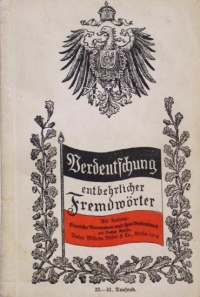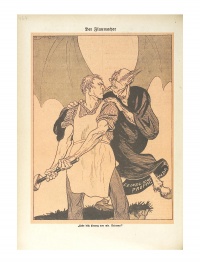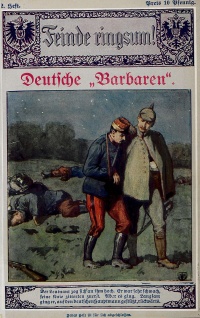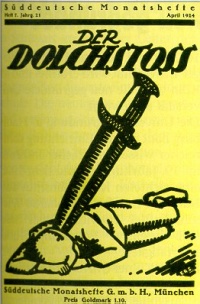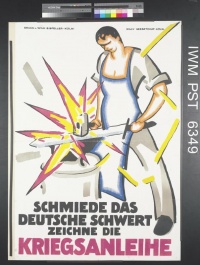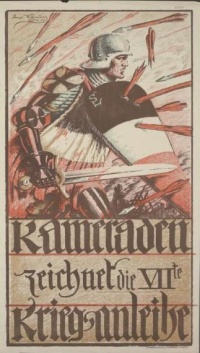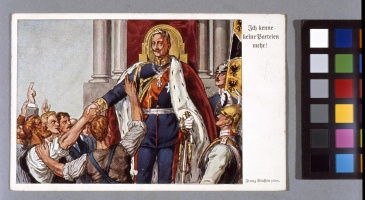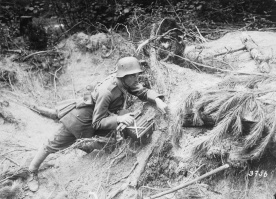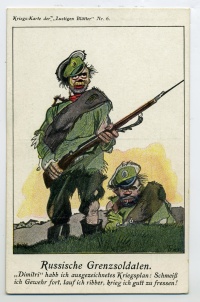Defining war propaganda↑
The French Revolution led Europe's political leaders to recognize that public opinion, expressed through agitation and action, was turning into a significant political force, which could no longer be ignored or merely controlled by censorship.[1] In order to promote a particular agenda, political decision-makers thus sought to actively influence public discourse, initially mainly through the press.[2] Napoleon I, Emperor of the French (1769-1821) was the first statesman to use both censorship and propaganda strategically – in order to stabilize his reign and rally support for his warfare.[3] His military opponents, however, also began to devise successful propaganda campaigns, thus elevating political ideology to a means of warfare.[4] In spite of the fact that it grew more and more common to employ propaganda as a political weapon, the same circles that employed it, associated the term with the extremely negative connotations of subversion and manipulation.[5] Yet, contemporaries simply ignored this contradiction, by accusing their enemies of distributing propaganda lies, while claiming that their own efforts were merely intended to inform or educate the public.[6]
Neither of these perceptions, however, provides a suitable basis for analyzing the various and changing sources, channels and themes of propaganda during the First World War. Although Bernd Hüppauf, for example, remains close to the contemporary demonization of propaganda by describing it as the “absolute opposite of the truth”, this approach unnecessarily limits the historian’s focus.[7] While aptly describing much of Germany’s official wartime PR, it explicitly excludes manifold popular attempts to fuel war enthusiasm which did not intentionally set out to deceive.
German wartime propaganda at the home front was not a straightforward “top down” affair. Official attempts to influence public opinion (through censorship and press conferences as well as propaganda posters, publications and events) existed alongside numerous popular endeavors to delineate the parameters of Germany’s wartime identity (such as letters to the editor; war poems and images; teachers’, university professors’ and pastors’ speeches; or war-themed merchandise). The motivations for such propaganda ranged from ideological conviction to commercial interest and its manifestations did not merely adopt the official message but also followed its own agenda. In order to encompass the wide range of efforts to “sell” the war to the German nation, this article considers all attempts to set the symbolic parameters of the national wartime identity as propaganda.
Ideological preparation for war↑
War propaganda was not a phenomenon that suddenly emerged in 1914 and ceased to exist in 1918. The fact that many Germans were prepared to heed the Kaiser’s call to arms both literally and ideologically stemmed from longstanding national ideals and convictions. Long before the outbreak of war, significant sections of Germany’s bourgeois society accepted obedience, unquestioning loyalty, bravery and discipline as the main characteristics of an ideal monarchist subject.[8] This elevation of military values to social guidelines paved Germany’s way into mobilization.
Equally common Nationalist and Social Darwinist ideologies also predisposed many Germans to perceive conflict as inevitable in 1914.[9] The leading principle in these – that political power is based on struggle – implied that only armed conflict could secure the nation’s survival.[10] This notion tied into an omnipresent perception of threat, evident in the German fear of “encirclement” by envious and belligerent neighbours.[11] Such beliefs transcended class boundaries and motivated even the Social Democratic Party (SPD) to support imperialist legislation and to increase armament spending prior to 1914.[12]
Such ideals and convictions were not spread solely by political and military institutions in order to rally support for increased armament funding. They were also upheld by interest-group agitation; promoted by intellectual circles; taught in schools and universities; integrated into the rituals of youth organizations; spread from pulpits; and even found their expression in a bourgeois fashion of sailor suits for boys.[13] Many of the same social groups later undertook similar efforts to gather support for the war effort – thus providing a pool of unofficial war propagandists intended to shape the public perception of the war through clubs, lectures, slideshows, concerts, brochures or public appeals.[14]
The pre-war press also played a crucial role in setting the mood for war. Although Bernhard Rosenberger could not verify his original hypothesis that the German press had explicitly fanned war enthusiasm between 1905 and 1914, he argued that increasingly negative depictions of the Entente and decreasing references to a peaceful solution to international tensions gradually shaped the public perception of war as inevitable.[15] In late July and early August, press reports actively contributed to the onset of war. On 30 July 1914, the Berliner Lokal-Anzeiger falsely stated that Germany had been ordered to mobilize, and thus contributed to the Russian decision to follow suit.[16] Similarly, fabricated newspaper reports that the French had bombed Nuremberg were used by the government to declare war on France while representing it as a defensive response to unwarranted attacks.[17]
August 1914: Popular war propaganda↑
Public discourse in the immediate aftermath of Germany’s mobilization was largely defined by popular war propaganda: journalists, intellectuals and artists, as well as ordinary Germans, sought to convey their interpretations of the conflict through war affirmative articles or letters to the editor.[18] In early August 1914, newspaper editorials across Germany were also flooded with roughly 50,000 daily offers for war poems.[19] Such poetry promoted martial ideals and patriotism, called for national unity, and promoted crude enemy typecasts, thus prescribing Germany’s wartime mindset and justifying the nation’s decision to go to war. Similar symbols and stereotypes reappeared in popular postcards, satirical journals, newspaper riddles, children’s books, commercial musicals and cinema entertainment.[20]
Two factors particularly defined the nature of First World War propaganda: its inclusion in mass media, which reached all layers of society by 1914, and a widespread use of images to portray a particular interpretation of the conflict.[21] Soon after the outbreak of war, private publishing houses began to translate the key sentiments of both official and popular propaganda into images.[22] By producing war-themed postcards they responded to the practical need for communication between front and home front and set the conversational framework for such exchanges.
War-themed postcards often contained a combination of patriotic, educative or humorous images and a memorable slogan. Such visual propaganda evoked stronger emotions and was more easily accessible than written wartime rhetoric, and thus reached a larger audience.[23] The constant repetition of certain slogans such as “Jeder Schuss ein Russ. Jeder Stoß ein Franzos. Jeder Tritt ein Brit” (“Every shot: a Russian. Every dig: a Frenchmen. Every kick: a Brit”) in combination with deprecatory images of Entente soldiers being shot, hit or kicked by German soldiers, condensed a whole set of implicit assumptions into a handy, memorable catchphrase.[24] This particular slogan (which was also scribbled on trains leaving for the front in 1914), implied the inferiority of enemy soldiers. It functioned as an assurance of a secure German victory, suggesting that well-disciplined German soldiers would fight spiritedly and effectively.[25] Negative and racist enemy stereotypes, however, were more common in privately published popular propaganda while official propaganda refrained from using such images on a large scale.[26]
Enemy caricatures as well as heroic and romanticized depictions of German soldiers were also conveyed by satirical publications such as Simplicissimus and the socialist Der wahre Jacob. Although the journals had been severely critical of militarism and the sabre rattling of Germany’s political elites before the war, both reasoned in 1914 that the defensive nature of the conflict warranted unlimited support.[27] They thus redefined their role from challengers of the status quo, to patriotic supporters of the war effort. The fact that these most critical watchdogs of the Kaiserreich had voluntarily joined the chorus of war propagandists, carried particular weight because they were renowned for their unwavering and incorruptible idealism.
Extreme, occasionally hysterical expressions of war enthusiasm were mostly confined to popular manifestations of “high culture”. By framing the war as a cultural struggle which only they had the authority to judge, Germany’s cultural and intellectual elites sought to regain their dwindling social influence.[28] This self-referential sentiment was particularly evident in the perception among artists that the conflict would – as the painter Max Beckmann (1884-1950) phrased it – prove to be “food for my art”.[29] It found its sad highlight in the infamous “Appeal to the Cultural World” from October 1914, which denied a breach of Belgian neutrality, repudiated violence against Belgian civilians and justified the destruction of Leuven as a necessary act of self-defense.[30] Germany’s intellectual elite also held Entente influences responsible for the “corruption” of German culture, thus calling for a rejection of all things “foreign”.[31] Such intellectual constructs, which tied into social Darwinist ideology, provided a cultural equivalent of the perception of military “encirclement”.
Although the surge of popular war propaganda in 1914 suggested that the population heeded the Kaiser’s call for unity, the manifold expressions of war enthusiasm did not reflect common goals. While some welcomed the conflict as a break from cultural stagnation, the genesis of national unity, or a chance to prove themselves in a military rite of passage, others desired to return to a pre-industrial society, or sought acceptance by joining the perceived “Volksgemeinschaft”.[32]
Official War propaganda 1914-1916: Upholding the “Burgfrieden”↑
In 1913, the General Staff had drawn up a memorandum stressing that nationwide public support was necessary to fight a future war.[33] Nevertheless, neither the government nor Germany’s military leadership had established a central institution to coordinate public relations with regard to the war.[34] As a result, official German propaganda in August 1914 was largely improvised and lacked coordination.[35] Yet, the necessity to quickly gain the upper hand in justifying the breach of Belgian neutrality focused official propaganda efforts.[36] Proposing a credible justification for this breach of international law was crucial, because any doubt cast on the defensive origin of the war would destroy a central premise of the “Burgfrieden”: the unifying assumption that the Kaiserreich was fighting a defensive war.
By establishing military control over the civil service and curtailing individual freedoms, the state of siege declared on 31 July 1914 provided the necessary requirements for war propaganda.[37] Broadly summarized, it followed three main objectives: imposing social control by preventing disagreeable reporting through censorship; providing suitable information to newspapers and other publications; and preventing the home front’s infiltration with enemy propaganda.[38] A fundamental basis of all three objectives was a deep-rooted mistrust of the population.[39] It was assumed that they would be easily swayed by enemy propaganda and thus had to be shielded from corrupting influences and educated to accept the desired interpretation of the war.[40] This pre-set agenda of instruction and control prevented those responsible for propaganda from taking evident popular predispositions into account, and thus prohibited a genuine inclusion of the population into Germany’s propaganda effort.
As it became evident that the war would not be decided by Christmas and people increasingly felt its hardship, underlying social conflicts and a consequential decline in popular propaganda became increasingly apparent.[41] Military and civilian authorities attributed great significance to this deterioration of public morale, because war weariness was perceived as a threat to the social order, a danger to the soldiers’ resolve and a sign of weakness towards the enemy.[42] Accordingly, home front morale was closely monitored by military intelligence officers to devise propaganda efforts accordingly and to intervene in cases of acute dissent.[43] The interpretation of dissatisfaction as moral deficiency and weakness rather than a response to genuine hardship, however, prevented propaganda authorities from addressing the popular war weariness in a constructive manner.[44]
Official Public Relations efforts↑
In order to control information released to the public and the perspective in which it was conveyed, the Deputy General Staff organized regular press conferences for journalists of all leading newspapers.[45] The pacifist Hellmut von Gerlach (1866-1935) characterized this official approach to “informing” the public by describing instructions journalists received during a military press conference in 1914: “[e]ven if half of the troops had been lost before Liège, you would still have to write that victory was accomplished with astonishingly few losses”.[46] Additionally, official information was distributed through news agencies of various ministries and the Wolffsche Telegraphenbüro (WTB). The latter co-operated closely with propaganda institutions and distributed official and semi-official statements, crucial international news and war reports.[47]
As journalists were not permitted to edit such reports, official PR and censorship measures led to a uniformity of news reports that failed to satisfy the popular desire for information and thus gradually eroded public trust in the press.[48] Propaganda that could be identified as untrue through civilians’ experiences or soldiers’ accounts further undermined confidence in official reports and gave rise to an informal exchange of information.[49] In response to a growing popular suspicion towards official propaganda, military and governmental institutions began to provide information to popular broadcasters and secretly funded independent propagandists in order produce seemingly impartial information.[50]
During the second half of the war, such “patriotic instruction” programmes, which were originally devised for the soldiers in July 1917 but soon transferred to the home front to boost public morale, were increasingly regulated by military authorities.[51] Among the convictions that such “patriotic instruction” was supposed to spread, were the Entente’s war guilt; confidence in the Oberste Heeresleitung (OHL) and German victory; rejection of a compromise peace; and condemnation of war profiteers and strikers.[52] Negative responses to “patriotic instruction” resulted in yet another official propaganda format: from late 1917, the Interior Ministry in Berlin arranged events of music and entertainment intended to distract the population while subtly conveying patriotic ideals.[53]
Official war propaganda 1916 – 1918: Commanding endurance↑
During the second half of the war, both methods and messages of official war propaganda shifted as it became evident that its central topoi – the “spirit of 1914” and the “national truce” – could no longer cover up the popular war weariness. A central impetus for this new approach was the need to secure financial funds for the war effort. Until 1917, the national bank and the treasury had not employed catchphrases or images to advertise war bonds, because they considered methods linked to political propaganda and advertising as crude and unsuitable for their purpose.[54] Instead, they successfully advertised for war loans through text posters, and prominent figures acting as disseminators of information – at least until September 1916.[55] When the fifth war loan proved less successful than its predecessor, propaganda efforts shifted to address a wider section of society by using visual and film material.[56]
Images on war loan posters, that focused on determined, heroic soldiers who relied on the home front’s financial support, subsequently promoted the “Volksgemeinschaft”, stressed the necessary unity of front and home front, and highlighted the need to persevere against adversity.[57] The (financial) success of this approach set the mode for future war loan campaigns and such symbolism was also adopted by other official propaganda institutions.[58]
A second factor contributing to the shift in official German propaganda was the rise of Erich Ludendorff (1865-1937) to the OHL in August 1916.[59] Ludendorff invested high hopes in propaganda and considered its success as a prerequisite for victory.[60] Inspired by the success of Allied propaganda films, he encouraged the establishment of the Image and Film Office (Bufa) which produced documentaries as well as fictional films and hosted archives for film and photo material.[61]
The novelty and appeal of war-themed films and documentaries, however, had worn off by 1915.[62] While officially sanctioned newsreels had initially evoked great interest among a population hungry for news from the front, the lack of genuine footage soon reduced such documentaries to an annoyance for cinema goers.[63] Propaganda films produced by the Bufa and the secretly state-financed production company Universum Film AG (Ufa) met a similar fate: although fictional war comedies or dramas had been popular in 1914, the blunt propaganda of official films was not well received by audiences in 1917.[64]
The Bufa’s handling of photographic material from the front also illustrates the above-mentioned paradigm shift in German war propaganda. During the first years of the war, Germany’s military leadership had allowed very few private photographers on the front lines and had severely censored all images, particularly those which could have shocked the home front.[65] From 1917, however, photographers employed by the Bufa were specifically instructed to take emotional pictures visualizing the soldiers’ struggle, death and destruction, to inspire popular endurance and belief in a German victory.[66] However, the fact that official war propaganda only made significant use of photographs once the population was largely disillusioned by the reality of war, may explain why such images had a greater impact on the memory rather than the contemporary perception of the war.[67]
As the increasing popular war weariness became apparent throughout 1917, senior civil servants as well as Vice Chancellor Friedrich von Payer (1847-1931) and Reich Chancellor Count Georg von Hertling (1843-1919) sought to reform the OHL's propaganda approach.[68] These government representatives sought advice from liberal and even social democratic circles in order to gauge the popular mood and to devise fitting measures to regain peoples' trust.[69] Anne Schmidt has defined the following propaganda aims as the core of these reformers' envisaged campaign: “unity, transparency, respect [and] cooperation”.[70] Aiming to devise war propaganda that took the people's disposition into account and addressed them directly in order to limit the OHL's influence, the government established its own press office in February 1918 and later founded a Zentralstelle für Heimatdienst (ZfH) to coordinate all propaganda efforts.[71] Such attempts to gain control of wartime propaganda, however, were met with significant opposition. Many government agencies, ministries and, above all, the OHL, refused to accept the ZfH's authority, ignored its guidelines and continued to follow their own agendas.[72] In response to the governmental bid for political control, Ludendorff retaliated by proposing the establishment of a Propaganda Ministry.[73] Although some of his demands for influential positions in the propaganda machinery were granted when the Crown Council decided to establish a “Central Office for Propaganda” in late August 1918, the October reforms and Germany's defeat eventually put the government in charge of public relations.[74]
Conclusion: A short Excursion to Post-war Propaganda↑
In spite of the manifold expressions of popular war enthusiasm in 1914, official attempts to gain the population’s loyalty were not rewarded with great success in the long run. As it became increasingly evident that the war would not be “over by Christmas”; that the population faced severe hardships; the war was not purely fought as a defensive response; and the population began to doubt official propaganda, the voluntary expressions of war enthusiasm waned. The much lauded “spirit of 1914” also developed a negative momentum because its high hopes could not be reconciled with the deprivations and suffering of wartime reality. Furthermore, recognition that promises of war propaganda were untrue contributed to the fact that attempts to instill war enthusiasm eventually fell on rather infertile ground. Examples for such disillusionment were: the pretension of national unity, which was challenged by obvious inequalities; the war aim debate; the failure of the U-boat war, which had been announced as Germany’s weapon for victory; and the collapse of Germany’s spring offensive in 1918. Ultimately, however, the most severe blow to the credibility of German war propaganda was the lack of military success. Promises of a glorious victory as a reward for wartime endurance contributed significantly to the revolutionary explosion of discontent when these hopes had been shattered.
This, by no means exhaustive summary of domestic German war propaganda, nevertheless illustrates a surprising resourcefulness of the political and military authorities, who had neither prepared extensive networks nor gathered much experience in leading public opinion before 1914. Considering these handicaps, the creation of such diverse channels for official and semi-official propaganda has to be regarded as a distinct success of the German propaganda effort. However, the German military leadership’s insistence on considering acceptance of propaganda as a matter of obedience rather than a process which depended upon the target group’s mindset, prevented military war propaganda from developing a lasting integrative dynamic.[75] Although more energy was invested to directly address the population after 1916, the fundamental deficit of the official propaganda machinery remained: those responsible proved unable or unwilling to understand popular emotions and grievances with regard to the war.
One particular aspect of war propaganda proved immensely effective in the long run, much to the disadvantage of the Weimar republic which consciously defined itself in opposition to wartime values. The censorship practice of obscuring Germany’s political and military misjudgments and the nature of Germany’s defeat, burdened the new state with the stab-in-the-back myth and left it unable to address either the war-guilt question or the peace negotiations with rational, factual arguments. This inability to genuinely uncover Germany’s wartime conduct allowed the republic’s right-wing opposition to undermine its legitimacy by reviving wartime propaganda ideals as alternatives to the revolutionary unrest and uncertainty.
Vanessa Ther, Independent Scholar
Section Editor: Christoph Cornelißen
Notes
- ↑ Lückemeier, Kai: Information als Verblendung. Die Geschichte der Presse und der öffentlichen Meinung im 19. Jahrhundert, Stuttgart 2001, pp. 54ff; Piereth, Wolfgang: Propaganda im 19. Jahrhundert. Die Anfänge aktiver staatlicher Pressepolitik in Deutschland, in: Daniel, Ute/Siemann, Wolfram (eds.): Propaganda. Meinungskampf, Verführung und politische Sinnstiftung 1789–1989, Frankfurt am Main 1994, p. 21; Bremm, Klaus-Jürgen: Propaganda im Ersten Weltkrieg, Darmstadt 2013, pp. 16ff.
- ↑ Piereth, Propaganda 1994, pp. 21f; Daniel, Ute: Die Politik der Propaganda. Zur Praxis gouvernementaler Selbstrepräsentation vom Kaiserreich bis zur Bundesrepublik, in: Daniel /Siemann Propaganda 1994, p. 54.
- ↑ Bremm, Propaganda 2013, p. 18.
- ↑ Ibid.
- ↑ Daniel, Ute / Siemann, Wolfram: Historische Dimensionen der Propaganda, in: idem (eds.): Propaganda. Meinungskampf, Verführung und politische Sinnstiftung 1789-1989, Frankfurt am Main 1994, p. 10f.
- ↑ Ibid., p. 7; Mruck, Tanja: Propaganda und Öffentlichkeit im Ersten Weltkrieg. Aachen 2004, p. 27; Kingsbury, Celia Malone: For Home and Country. World War I Propaganda on the Home Front [e-Book], London et al. 2010 (Kindle file), pos. 209.
- ↑ Hüppauf, Bernd: ‛Kriegsliteratur’, in: Hirschfeld, Gerhard/Krumeich, Gerd/Renz, Irina: Enzyklopädie Erster Weltkrieg. Paderborn et al. 2004, p. 181.
- ↑ Rohkrämer, Thomas: August 1914 – Kriegsmentalität und ihre Voraussetzungen, in: Michalka, Wolfgang (ed.): Der Erste Weltkrieg. Wirkung, Wahrnehmung, Analyse, 1994, p. 761; Ulrich, Bernd / Vogel, Jakob / Ziemann, Benjamin (eds.): Untertan in Uniform. Militär und Militarismus im Kaiserreich 1871 – 1914. Quellen und Dokumente, Frankfurt am Main 2001, p. 187.
- ↑ Nübel, Christoph: Bedingt kriegsbereit. Kriegserwartungen in Europa vor 1914, in: Apuz. Aus Politik und Zeitgeschichte 63/12 (2013), pp. 23ff; Lückemeier, Information 2001, pp. 428, 433f.
- ↑ Nübel, Bedingt kriegsbereit 2013, p. 23.
- ↑ Mai, Gunther: “Verteidigungskrieg“ und “Volksgemeinschaft“ Staatliche Selbstbehauptung, nationale Solidarität du soziale Befreiung in Deutschland in der Zeit des Ersten Weltkriegs (1900 – 1925), in: Michalka (ed.): Weltkrieg 1994, p. 585; Lückemeier, Information 2001, pp. 438f.
- ↑ Mai, “Verteidigungskrieg“ 1994, p. 585; Rohkrämer, August 1994, pp. 75ff; Welch, David: Germany, Propaganda and Total War, 1914 – 1918, London 2000, p. 25.
- ↑ Nübel, Bedingt kriegsbereit 2013, p. 27; Rohkrämer, August 1994, pp. 762ff, 769; Fries, Helmut: Deutsche Schriftsteller im Ersten Weltkrieg, in: Michalka, Erste Weltkrieg Munich 1994, p. 834.
- ↑ Welch, Germany, Propaganda 2000, p. 33; Kruse, Wolfgang: Die Kriegsbegeisterung im Deutschen Reich, in: van der Linden, Marcel/Mergner, Gottfried (eds.): Kriegsbegeisterung und mentale Kriegsvorbereitung. Berlin 1991, S. 73-87, p. 84.
- ↑ Rosenberger, Bernhard: Zeitungen als Kriegstreiber? Die Rolle der Presse im Vorfeld des Ersten Weltkrieges, Cologne et al. 1998, pp. 282ff, 289ff, 293; also see Rohkrämer, August 1994, p. 760; Lückemeier, Information 2001, p. 428.
- ↑ Mruck, Propaganda 2004, p. 154.
- ↑ Jeismann, Michael: Propaganda, in: Hirschfeld/Krumeich/Renz (eds.), Enzyklopädie 2004, p. 200; Lückemeier, Information 2001, pp. 455ff.
- ↑ Lückemeier, Information 2001, p. 464.
- ↑ Jelavich, Peter: German Culture in the Great War, in: Roshwald, Aviel / Stites, Richard (eds.): The Arts, Entertainment, and Propaganda, 1914 – 1918. Cambridge 2002, pp. 32f.
- ↑ Weigel, Hans/Lugan, Walter/Peyfuss, Max D. (eds.): Jeder Schuss ein Russ, Jeder Stoss ein Franzos. Literarische und graphische Kriegspropaganda, in: Deutschland und Österreich 1914 – 1918. Vienna 1983, pp. 49-59; Oberschelp, Reinhard: Viel Feind, viel Ehr! Rätsel aus dem Ersten Weltkrieg als Übermittler von Kriegspropaganda, Hildesheim 1992; Müller, Sonja: Toys, games and juvenile literature in Germany and Britain during the First World War. A Comparison, in: Jones, Heather / O’Brien, Jennifer / Schmidt-Supprian, Christoph (eds.): Untold War. New Perspectives in First World War Studies, Leiden et al. 2008, pp. 244f.
- ↑ Lückemeier, Information 2001, pp. 337f.
- ↑ For an interesting selection of postcard motives see: Deutsches Historisches Museum / Directmedia Publishing GmbH (ed.): Digitale Bibliothek 66. Der Erste Weltkrieg in deutschen Bildpostkarten, Berlin 2002.
- ↑ Bruendel, Steffen: Vor-Bilder des Durchhaltens. Die deutsche Kriegsanleihe-Werbung 1917/18, in: Bauerkämper, Anne/Julien, Elise (ed.): Durchhalten! Krieg und Gesellschaft im Vergleich 1914 – 1918, Göttingen 2010, p. 86.
- ↑ See for example: Deutsches Historisches Museum: Digitale Bibliothek Volume 66 2002, pp. 1184, 1190f.
- ↑ Jeismann, Propaganda 2004, p. 199.
- ↑ Schmidt, Anne: Belehrung – Propaganda – Vertrauensarbeit. Zum Wandel amtlicher Kommunikationspolitik in Deutschland 1914 – 1918, Essen 2006, pp. 239f.
- ↑ Schütze, Christian: Die Geschichte des Simplicissimus, in: Ibid. (ed.): Facsimile Querschnitt durch den Simplicissimus. Vienna 1960, p. 15; Schütz, Hans J. (ed.): Der wahre Jacob. Ein halbes Jahrhundert in Faksimiles, Berlin et al. 1977, p. VII, X.
- ↑ Jelavich, German Culture 2002, pp. 42ff; Fries, Deutsche Schriftsteller 1994, pp. 836ff; Lückemeier, Information 2001, p. 463; Kruse, Kriegsbegeisterung 1991, p. 74.
- ↑ Fries, Deutsche Schriftsteller 1994, p. 829.
- ↑ Jelavich, German Culture 2002, pp. 44ff; von Ungern-Sternberg, Jürgen / von Ungern-Sternberg, Wolfgang: Der Aufruf “An die Kulturwelt!” Das Manifest der 93 und die Anfänge der Kriegspropaganda im Ersten Weltkrieg, Stuttgart 1996, pp. 144-147.
- ↑ Fries, Deutsche Schriftsteller 2000, pp. 46, 59; Lückemeier, Information 2001, p. 462.
- ↑ Mai, “Verteidigungskrieg“ 1994, pp. 760f; Rohkrämer, August 1994, pp. 764ff, 772; Welch, Germany 2000, pp. 12f; Kruse, Kriegsbegeisterung 1991, p. 83.
- ↑ Nübel, Bedingt kriegsbereit 2013, p. 22; Schmidt, Belehrung 2006, p. 43.
- ↑ Altenhöner, Florian: Kommunikation und Kontrolle. Gerüchte und städtische Öffentlichkeiten in Berlin und London 1914/1918, Munich 2008, p. 28.
- ↑ Ibid., p. 28; Welch, Germany 2000, p. 21f.
- ↑ Welch, Germany 2000, pp. 24f.
- ↑ Ibid., p, 14; Schmidt, Belehrung 2006, pp. 32f; Altenhöner, Kommunikation 2008, p. 39.
- ↑ Mruck, Propaganda 2004, p. 19; Altenhöner, Kommunikation, p. 91.
- ↑ Schmidt, Belehrung 2006, pp. 38-42.
- ↑ Ibid., pp. 66f; Mruck, Propaganda 2004, p. 152; Altenhöner, Kommunikation 2008, p. 68.
- ↑ Schmidt, Belehrung 2006, pp. 50-56.
- ↑ Ibid., pp. 48f, 72.
- ↑ Ibid., p. 49; Altenhöner, Kommunikation 2008, p. 89.
- ↑ Ibid., pp. 58-61, 127ff, 133ff; Welch, Germany 2000, p.166.
- ↑ Schmidt, Belehrung 2006, pp. 73f.
- ↑ Donat, Helmut / Wild, Adolf (eds.): Hellmut von Gerlach: Die grosse Zeit der Lüge. Der Erste Weltkrieg und die deutsche Mentalität (1871-1921), Bremen 1994, p. 124.
- ↑ Schmidt, Belehrung 2006, p. 75; Altenhöner, Kommunikation 2008, p. 70.
- ↑ Welch, Germany 2000, pp. 39f; Altenhöner, Kommunikation 2008, pp. 157, 163, 209; Schmidt, Belehrung 2006, p. 57.
- ↑ Schmidt, Belehrung 2006, p. 57; Altenhöner, Kommunikation 2008, pp. 154, 163, 166f, 209.
- ↑ Schmidt, Belehrung 2006, pp. 77f, 80f, 155.
- ↑ Ibid., pp. 170ff; Welch, Germany 2000, pp. 202, 207; Pöhlmann, Marcus: Vaterländischer Unterricht, in: Hirschfeld, Gerhard / Krumeich, Gerd Irina Renz: Enzyklopädie Erster Weltkrieg. Paderborn et al. 2004, p. 941.
- ↑ Welch, Germany 2000, p. 209.
- ↑ Altenhöner, Kommunikation 2008, p. 227.
- ↑ Bruendel, Vor-Bilder 2010, pp. 85ff.
- ↑ Ibid., pp. 85ff.
- ↑ Ibid., pp. 86f; Schmidt, Belehrung 2006, pp. 89 f, 106f.
- ↑ Bruendel, Vor-Bilder 2010, pp. 88f, 92, 94, 98.
- ↑ Ibid., p. 87; Schmidt, Belehrung 2006, p. 90.
- ↑ Schmidt, Belehrung 2006, p. 115.
- ↑ Ibid., pp. 119-123.
- ↑ Jelavich, German Culture 2002, pp. 39 ff, 55; Schmidt, Belehrung 2006, pp. 158ff.
- ↑ Stiasny, Philipp: Das Kino und der Krieg. Deutschland 1914 – 1929, Munich 2009, pp. 27f.
- ↑ Stiasny, Kino und Krieg 2009, pp. 28f.
- ↑ Stiasny, Kino und Krieg 2009, pp. 34f, 37, 43.
- ↑ Schmidt, Belehrung 2006, pp. 161f.
- ↑ Ibid., pp. 165f.
- ↑ Holzer, Anton: Den Krieg sehen. Das fotografische Gesicht des Krieges, in: Ibid.: Mit der Kamera bewaffnet. Krieg und Fotografie, Marburg 2004, p. 60.
- ↑ Schmidt, Belehrung 2006, p. 185.
- ↑ Ibid., pp. 186-191.
- ↑ Ibid., pp. 198.
- ↑ Ibid., pp. 198, 208f.
- ↑ Ibid., pp. 215-223.
- ↑ Ibid., pp. 220f, Welch, Germany 2000, p. 229.
- ↑ Schmidt, Belehrung 2006, pp. 221; Welch, Germany 2000, p. 241.
- ↑ Schmidt, Belehrung 2006, pp. 64; 142-152, 248f; Welch, Germany 2000, pp. 21, 254; Mruck, Propaganda 2004, pp. 32, 119.
Selected Bibliography
- Altenhöner, Florian: Kommunikation und Kontrolle. Gerüchte und städtische Öffentlichkeiten in Berlin und London 1914/1918, Munich 2008: Oldenbourg.
- Arnold, Sabine R. / Daniel, Ute / Siemann, Wolfram (eds.): Propaganda. Meinungskampf, Verführung und politische Sinnstiftung (1789-1989), Frankfurt a. M. 1994: Fischer Taschenbuch Verlag.
- Bremm, Klaus-Jürgen: Propaganda im Ersten Weltkrieg, Stuttgart 2013: Theiss.
- Bruendel, Steffen: Vor-Bilder des Durchhaltens. Die deutsche Kriegsanleihe-Werbung 1917/1918, in: Bauerkämper, Arnd / Julien, Elise (eds.): Durchhalten! Krieg und Gesellschaft im Vergleich 1914-1918, Göttingen 2010: Vandenhoeck & Ruprecht, pp. 82-108.
- Deutsches Historisches Museum (ed.): Digitale Bibliothek 66. Der Erste Weltkrieg in deutschen Bildpostkarten (CD-ROM), Berlin 2002: DirectMedia.
- Hirschfeld, Gerhard / Krumeich, Gerd / Renz, Irina (eds.): Enzyklopädie Erster Weltkrieg, Paderborn 2014: Schöningh.
- Jeismann, Michael: Propaganda, in: Hirschfeld, Gerhard / Krumeich, Gerd / Renz, Irina (eds.): Enzyklopädie Erster Weltkrieg, Paderborn 2003: Schöningh, pp. 198-209.
- Jelavich, Peter: German culture in the Great War, in: Roshwald, Aviel / Stites, Richard (eds.): European culture in the Great War. The arts, entertainment, and propaganda, 1914-1918, Cambridge; New York 1999: Cambridge University Press, pp. 32-57.
- Kingsbury, Celia Malone: For home and country. World War I propaganda on the home front, Lincoln 2010: University of Nebraska Press.
- Lückemeier, Kai: Information als Verblendung. Die Geschichte der Presse und der öffentlichen Meinung im 19. Jahrhundert, Stuttgart 2001: Ibidem-Verlag.
- Michalka, Wolfgang / Militärgeschichtliches Forschungsamt (eds.): Der Erste Weltkrieg. Wirkung, Wahrnehmung, Analyse, Munich 1994: Piper.
- Mruck, Tanja: Propaganda und Öffentlichkeit im Ersten Weltkrieg, Aachen 2004: Shaker.
- Nübel, Christoph: Bedingt kriegsbereit. Kriegserwartungen in Europa vor 1914, in: Aus Politik und Zeitgeschichte 63/12, pp. 22-27.
- Rosenberger, Bernhard: Zeitungen als Kriegstreiber? Die Rolle der Presse im Vorfeld des Ersten Weltkrieges, Cologne 1998: Böhlau.
- Schmidt, Anne: Belehrung, Propaganda, Vertrauensarbeit. Zum Wandel amtlicher Kommunikationspolitik in Deutschland, 1914-1918, Essen 2006: Klartext Verlag.
- Stiasny, Philipp: Das Kino und der Krieg. Deutschland 1914-1929, Munich 2009: Edition Text + Kritik.
- Weigel, Hans / Lukan, Walter / Peyfuss, Max Demeter: Jeder Schuss ein Russ, jeder Stoss ein Franzos. Literarische und graphische Kriegspropaganda in Deutschland und Österreich, 1914-1918, Vienna 1983: C. Brandstätter.
- Welch, David: Germany, propaganda, and total war, 1914-1918. The sins of omission, New Brunswick 2000: Rutgers University Press.







